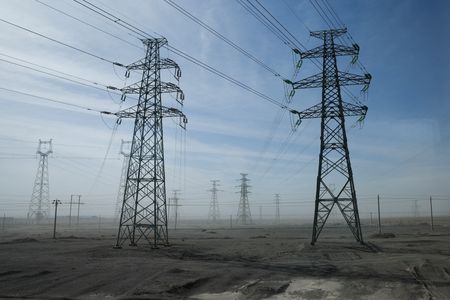By Joe Cash and Xiuhao Chen
BEIJING (Reuters) -Days of record-breaking heat across large swathes of China pushed power demand to an all-time high in excess of 1.5 billion kilowatts on Wednesday, energy officials said, with temperatures forecast to feel like 50 degrees Celsius (122 degrees Fahrenheit) in some areas on Thursday.
An arc of sweltering heat stretching from the densely populated city of Chongqing in the southwest to Guangzhou on the coast has enveloped an area home to over 200 million people in recent days.
A subtropical high pressure system, which causes warm and dry weather, drove temperatures at eight weather stations in the northwest and southwest of China to record highs in the last two days, state media said on Thursday, citing national weather authorities.
“The power system is holding up so far,” said Chim Lee, a senior energy and climate change specialist at the Economist Intelligence Unit.
“But the real test will come as the summer wears on, and there are still risks of potential power rationing,” he added.
Solar energy accounted for half of June’s surge in power generation. Hydropower output nationwide was up on 2023, though still lower than the corresponding 2022 period, Lee said.
China’s National Energy Administration flagged a “record high” on Wednesday in the country’s electrical load for the third time this month.
That was an increase of 55 million kilowatts over last year’s maximum. Provincial records have also been broken 36 times since summer began in the world’s second-largest economy.
In some parts of the central provinces of Hubei and Hunan, which are the same size as Italy and Britain, respectively, apparent temperatures – a measure of how hot the combination of temperatures, humidity and wind make people feel – were forecast to reach as high as 50 C on Thursday.
Similar apparent temperatures were also expected in the southern provinces of Jiangxi and Guangdong – home to populations equivalent to those of Spain and Mexico.
Besides scorching croplands and eroding farm incomes, higher temperatures can affect manufacturing hubs and disrupt operations in key ports, straining overburdened healthcare.
But the scorching heat is also giving consumer spending a boost.
Sales of air conditioners and handheld fans have surged 112% and 103% month-on-month, respectively, according to Chinese e-commerce giant JD.com . The catering sector has also seen a notable rise in demand, as people seek out cool refreshments.
“It could improve consumer sentiment as it is helping sales of air conditioning, which is a big household appliance,” said Dan Wang, China director at Eurasia Group in Singapore. “And the services sector can expect to get a boost, as people escape the heat by going to watch a movie.”
‘SANFU SEASON’
The heat is expected to persist.
China’s “Sanfu Season” — an agricultural marker believed to have been in use for over two millennia — typically begins in mid-July and lasts through late August, denoting the peak of summer.
It is forecast to run from Sunday to August 19 this year.
In response to the early high temperatures, state broadcaster CCTV last week spotlighted a tradition of people sleeping with wax gourds, vegetables considered effective in absorbing body heat.
Over the past decade, the southern province of Jiangxi has experienced an annual average of 21.7 days of temperatures above 28 C, up from five to seven at the turn of the century, state media added.
There is a chance of some respite, however.
Weather forecasters expect temperatures to begin easing from Monday, as a tropical depression east of the Philippines may strengthen into a tropical storm expected to be named Wipha, and track across Taiwan toward southern China.
However, the low-pressure system could be blocked from advancing north by the subtropical high, keeping air conditioners running at full tilt and further straining the power grid.
(Reporting by Joe Cash and Xiuhao Chen; Editing by Clarence Fernandez and Joe Bavier)








